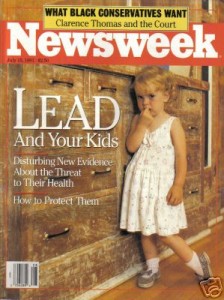15 Feb Media Matters: How Journalists Paved The Way For Healthy Housing With A Story About Lead
Today, in celebration of long time BRG client National Center for Healthy Housing (NCHH) and its 20th Anniversary, we are going to tell you a story about a journalist who uncovered an epidemic of epic proportions. His story sparked the healthy homes movement in the United States and paved the way for the work NCHH does every day keeping families safe and healthy within their own homes. As we communications professionals know, media has influence and their power can bring issues to light and ignite positive change in the way people live. This was one of those times.
The story that paved the way for healthy housing
In the early 90’s, then Newsweek national correspondent Steven Waldman, made the case to write a story on what seemed like a quiet yet very alarming issue about children, lead paint and the apparent health effects.
Discovery: Lead paint all over America
Waldman’s research uncovered the connection between the families with children diagnosed with lead poisoning – exposure to lead paint. Although lead paint itself was removed from most paint in the 1950s, it was still in households across America. Lead paint wasn’t just present in low-income neighborhoods either. Seventy five percent of all private housing built before 1980 had some lead paint.
Children who consumed paint chippings stuck to their fingers or toys, or were exposed to lead dust from home renovations, for example, were at risk for lead poisoning.
Evidence showed that even small doses of lead could reduce a child’s IQ and slow their development. Americans needed to know.
Waking up America

Image via Newsweek
The 1991 Newsweek cover story, Lead and Your Kids, featured a little girl impacted by lead poisoning. Waldman’s reporting included data from the CDC revealing that over 3,000,000 children had lead poisoning, one of every six preschoolers. In inner cities, one in every two children had lead poisoning. This statistic illustrated a connection between poor housing conditions and health disparities. While the data was shocking, there was good news. Lead poisoning was something that could be prevented.
At the time, there were no lead-safety standards for affordable housing. The following year, prevention-based laws were created, and the National Center for Lead-Safe Housing (now NCHH) was created. Over the past 20 years, NCHH has coordinated efforts to dramatically reduce the number of children exposed to, and impacted by lead poisoning. Additionally, they have worked to reduce other harmful conditions that exist in housing, from radon to mold.
Lead and Your Kids: The 20-year reunion
This week at NCHH’s 20th Anniversary Healthy Housing Leadership Conference, Waldman and fellow journalists shared their experiences related to the 1991 lead article and other resulting stories. It’s not often that you get to hear firsthand from the actual players that brought an issue into the public eye and made people take notice.
To move a community and policy makers into action, the journalists needed to create a groundswell of factual information that the public couldn’t help but read. Developing a truly impactful story takes care, crafting, diligence and packaging.
In today’s world, they acknowledged that the same components must go into a story to forge such results. However, due to the resource constraints of newsrooms and decline of daily newspapers, the duty to provide that same level of detail can no longer be that of individual reporters. Organizations today need to share that burden with reporters to increase the likelihood that the right story gets told. It’s an interesting perspective on the changing face of news.






